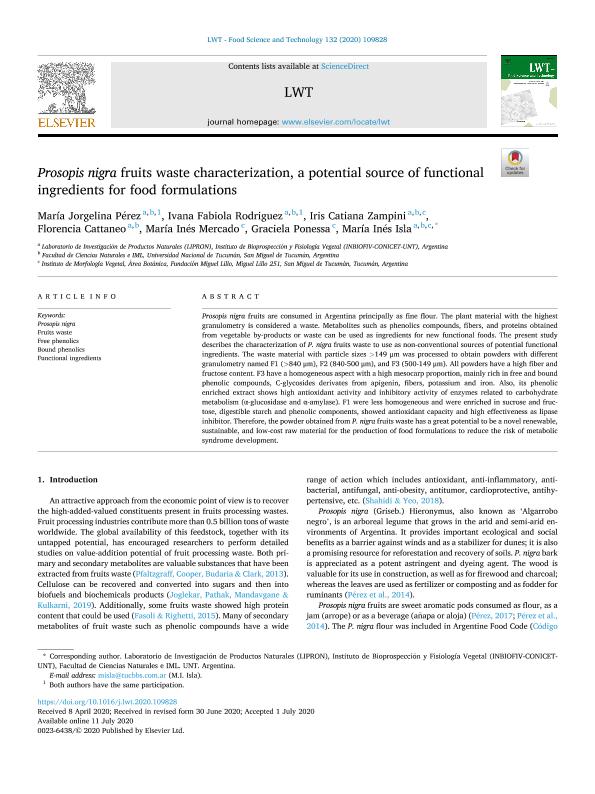Artículo
Prosopis nigra fruits waste characterization, a potential source of functional ingredients for food formulations
Perez, Maria Jorgelina ; Rodriguez, Ivana Fabiola
; Rodriguez, Ivana Fabiola ; Zampini, Iris Catiana
; Zampini, Iris Catiana ; Cattaneo, Florencia
; Cattaneo, Florencia ; Mercado, Maria Ines
; Mercado, Maria Ines ; Ponessa, Graciela Ines; Isla, Maria Ines
; Ponessa, Graciela Ines; Isla, Maria Ines
 ; Rodriguez, Ivana Fabiola
; Rodriguez, Ivana Fabiola ; Zampini, Iris Catiana
; Zampini, Iris Catiana ; Cattaneo, Florencia
; Cattaneo, Florencia ; Mercado, Maria Ines
; Mercado, Maria Ines ; Ponessa, Graciela Ines; Isla, Maria Ines
; Ponessa, Graciela Ines; Isla, Maria Ines
Fecha de publicación:
10/2020
Editorial:
Elsevier Science
Revista:
LWT - Food Science and Technology
ISSN:
0023-6438
Idioma:
Inglés
Tipo de recurso:
Artículo publicado
Clasificación temática:
Resumen
Prosopis nigra fruits are consumed in Argentina principally as fine flour. The plant material with the highest granulometry is considered a waste. Metabolites such as phenolics compounds, fibers, and proteins obtained from vegetable by-products or waste can be used as ingredients for new functional foods. The present study describes the characterization of P. nigra fruits waste to use as non-conventional sources of potential functional ingredients. The waste material with particle sizes >149 μm was processed to obtain powders with different granulometry named F1 (>840 μm), F2 (840-500 μm), and F3 (500-149 μm). All powders have a high fiber and fructose content. F3 have a homogeneous aspect with a high mesocarp proportion, mainly rich in free and bound phenolic compounds, C-glycosides derivates from apigenin, fibers, potassium and iron. Also, its phenolic enriched extract shows high antioxidant activity and inhibitory activity of enzymes related to carbohydrate metabolism (α-glucosidase and α-amylase). F1 were less homogeneous and were enriched in sucrose and fructose, digestible starch and phenolic components, showed antioxidant capacity and high effectiveness as lipase inhibitor. Therefore, the powder obtained from P. nigra fruits waste has a great potential to be a novel renewable, sustainable, and low-cost raw material for the production of food formulations to reduce the risk of metabolic syndrome development.
Archivos asociados
Licencia
Identificadores
Colecciones
Citación
Perez, Maria Jorgelina; Rodriguez, Ivana Fabiola; Zampini, Iris Catiana; Cattaneo, Florencia; Mercado, Maria Ines; et al.; Prosopis nigra fruits waste characterization, a potential source of functional ingredients for food formulations; Elsevier Science; LWT - Food Science and Technology; 132; 10-2020; 1-10
Compartir
Altmétricas



